Vision Statement

What Is It?
Vision statements are aspirational, long term goals describing the impact your product will have on the future. They are often referred to as a product’s “north star” since you will look to your vision statement for guidance while navigating your product’s strategy, roadmap, and experiments.
Why Do It?
Crafting a vision statement builds collective ownership of the product’s long term value, aligns stakeholders on the product’s goals, and serves as the backbone for decisions around product direction. The vision statement is one of the first places you will determine and communicate the “why” behind your product, which is a crucial starting step for any product manager.
When To Do It?
It is strongly recommended to create or revisit the vision statement as one of the first things you do with your product
Who To Involve?
Product Managers, Designers, Engineers, Stakeholders, Users
Tools You Might Need
Whiteboarding tool (figjam, miro) or Post-Its and sharpies.
How To Do It (Steps)
-
Understand the Market and User Needs
-
Before crafting a product vision statement, it's essential to thoroughly understand the market landscape, target audience, and their needs. This involves conducting market research, analyzing competitor and domain products, gathering user feedback from stakeholders and end users, and identifying trends and opportunities. Understanding the problem your product aims to solve and the value it provides to users is fundamental in shaping the product vision.
-
It’s important to refer to the contract, scoping outbrief, and kickoff materials that helps to understand the deliverables.
-
-
Define the Product's Purpose and Value Proposition
-
The product vision statement should articulate the purpose of the product and its value proposition succinctly. The statement should be inspiring, aspirational, and forward-thinking, conveying the long-term vision for the product and its potential impact on users and the market. It may answer some of these questions such as:
-
What problem does the product solve for users?
- What benefits or outcomes does the product offer?
- What makes the product unique or better than existing solutions?
- How does the product align with the company's mission and goals?
-
-
Communicate the Vision Clearly and Concisely
-
Once the product vision has been defined, it's crucial to communicate it clearly and concisely to all stakeholders, including the development team, leaders and stakeholders.
-
The vision statement should be easily understood and memorable, serving as a guiding beacon for decision-making and prioritization throughout the product development lifecycle. It should inspire and motivate the team, fostering a sense of purpose and direction as they work towards realizing the product vision.
-
Tips & Tricks
Keep it concise: Vision statements should be a single sentence where each word is carefully justified. It can be helpful to sit with your team, highlight each word in the vision one by one, and ask how it contributes to the rest of the statement.
Make it impactful & inspirational: You are communicating the long term vision of your product, so it is okay to think big. An inspiring vision statement helps build excitement around your product both internally and externally.
Support your organization’s vision: Having a vision statement that can roll up into the vision of your organization will help ensure your product contributes to the overall success of the organization.
Avoid solutions: A vision statement should reflect the “what” and the “why” behind your product’s impact but not the “how.” This leaves room for you to experiment with how to achieve the vision over time.
Get help writing one: We recommend crafting a vision statement as an exercise with your team and iterating on it with external feedback. This will build early alignment and collective ownership of your product, plus it helps avoid analysis paralysis over each word.
Examples
Google’s vision statement is: To provide access to the world's information in one click. It starts with what the company is setting out to do, which is to provide access to information. They then introduce the descriptors of not only accessing the entire world’s information, but also being able to do so in one click. This sets aspirational future goals for both breadth of information available as well as ease of access and effectively communicates the value Google can add if they are able to make progress towards this vision.
Here are some mock examples of vision statements for DoD organizations:
To improve transparency and efficacy of space tasking Space Orders Generation
Equip every warfighter with lifesaving skills First Aid Training App
Connect every sensor, operator, and shooter Data Broker for TacC2
Nearly every company and product has a vision statement, so we encourage you to read the vision statements of companies you admire for more examples and inspiration. Pay attention to the word choice and think about how the company’s products are positioned to contribute to their vision.
Vision vs. Mission Statements
Many organizations have both a vision and a mission statement and it can sometimes be confusing to differentiate between the two, especially since they are often (incorrectly) used interchangeably. The simplest way to distinguish between them is to think about vision statements communicating a future state while mission statements represent the current state of business operations. If we return to Rise8 as an example, our mission statement is to continuously deliver impactful software warfighters love. This does not describe our future goal of mission dominance, rather it describes our focus today.
Here are some other examples of mission statements:
Google: Organize the world's information and make it universally accessible and useful
Ford: To make people's lives better by making mobility accessible and affordable
We strongly encourage having a vision statement for your team but whether or not you also want a mission statement is up to you. If you decide to write one, follow the same principles as a vision statement but think about addressing the “how” in the present versus the “what” and “why” in the future.